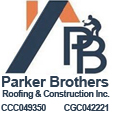Roofing Tips
Roof Checkup Guide for Homeowners
A checkup on your roof system in the fall and spring will help diagnose potential problems early.
NRCA recommends you hire a profession roofing contractor to assist you with checking your roof. However, NRCA
realizes many homeowners prefer to perform an initial inspection themselves. If you prefer to go that route, the
following are some important tips to get you started.
When cleaning your gutters or inspecting your roof system, remember these important ladder safety tips:
:: Make sure the ladder is on solid, level ground.
:: Secure the ladder at the top to prevent it from slipping.
:: Inspect the ladder, rungs and rails for damage.
:: Extend the ladder at least 3 feet beyond the gutter and angle it 1 foot back from the house for every 4 feet in eave height.
:: Always use both hands when climbing the ladder.
Once on the ladder, you should look for:
:: Shingles that are buckling, curling or blistering; this indicates the end of the shingle’s life expectancy.
:: Loose material or wear around chimneys, pipes and other penetrations.
:: Excessive amounts of shingle granules in your gutters; granules give shingles added weight and protect them from ultraviolet rays.
Before you hire a roofing contractor, do your homework:
:: Check for a contractor’s permanent place of business, telephone number and tax identification number.
:: Check references from prior customers.
:: Ask for proof of insurance- (liability and workers’ compensation*).
:: Ask the contractor about material and workmanship warranties.
*Note: U.S. workers’ compensation laws vary by state. Consult your state’s laws to determine workers’ compensation insurance requirements.
A Homeowners Guide to Buying a New Roof (FYI)
The National Roofing Contractors Association (NRCA) is pleased to provide you with this information as a part of our ongoing effort
to educate home and building owners about roofing and roofing contractors.
We hope this information will make you a more knowledgeable consumer and, when the times comes, a smart roof system buyer.
A new roof system is a big investment. We want to help you get a quality roof system at a fair price from a professional roofing contractor.
William A. Good, CAE
Executive Vice President
National Roofing Contractors Association
Roof System Components
All steep-slope roof systems (i.e., roofs with slopes of 25 percent or more) have five basic components:
- Roof covering: shingles, tile, slate or metal and underlayment that protect the sheathing from weather.
- Sheathing: boards or sheet material that are fastened to roof rafters to cover a house or building.
- Roof structure: rafters and trusses constructed to support the sheathing.
- Flashing: sheet metal or other material installed into a roof system’s various joints and valleys to prevent water seepage.
- Drainage: a roof system’s design features, such as shape, slope and layout that affect its ability to shed water.


